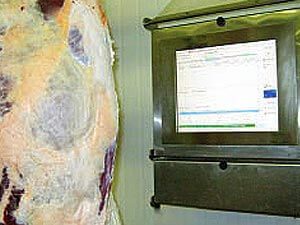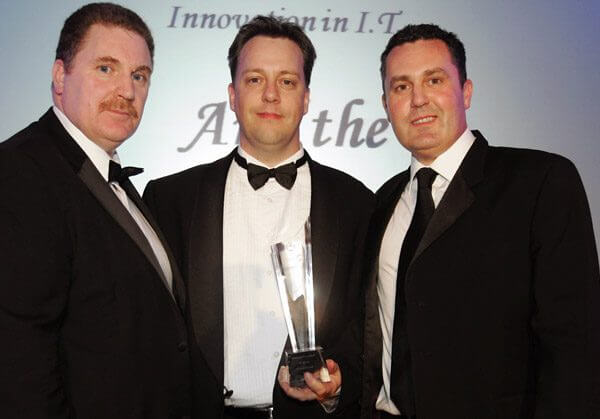
Emydex software in use on Meat Factory floor terminals.
Web-based systems to book animals into abattoirs, so-called ‘vet health systems’ to give quick feedback to farmers on animal health and meat quality, and radio frequency identification that allows automatic, paperless tracking of products in warehouses are already in use by bigger companies and may soon be in wider use.
The introduction of these system s into the meat processing sector has come as a wider range of purpose-designed software for the meat trade becomes available, revolutionising the way that the processing industry and the supply chain work. “Today there are a lot more areas of the plant talking to each other electronically,” says Christine Walsh of Meat & Livestock Commercial Services. Further similar developments are inevitable. They not only help plants save money by cutting back on repetitive paperwork and improving communications, but can also help with achieving better animal welfare and a lower carbon footprint.
Currently, the web-based booking-in system is being trialled only in the pig sector by Bpex. It is an electronic pig movement project, known as eAM L2, and was initially trialled at 15 abattoirs. Gradually, it is being rolled out to other plants and will go live across the industry in England and Wales next April. It com bines the Animal Movement Licence (AM L2) and Food Chain Information (FCI) form s — required when pigs are moved from farm to slaughter — and made the whole process electronic.
Dorothea Schiemann of Bpex says: “The producer fills in details of his consignment online before sending them for slaughter and the abattoir is emailed the information automatically early in the morning before the pigs arrive. As before, the abattoir confirms the number of pigs received, any pigs dead on arrival and the consignment’s unloading time. Only now, the information will be submitted online, which is quicker than handling the paper form s. The information is automatically uploaded to the central government database and a copy is sent to the local authority, so there is no longer a need for abattoirs to post AM L2 form s.” At the moment, the project covers farm -to-slaughter movements only, with farm -to-farm and farm -to-market/show to follow in due course. The system is funded by Defra and is free to use — all that is needed is a PC and internet access.
Such system s can save plants money, says Walsh. “The Meat Hygiene Service used to have to record this manually through the day and would spend a couple of hours at the end of shift completing their paperwork. This double entry can be eliminated to save time and money at the end of the day, as there is direct input through a portable touch screen interfaces at the time of inspection.” Similar system s for the whole supply chain may soon be developed for use by the beef and lamb sectors too, she says. In the abattoir Computers are also playing an increasing role in the slaughter hall. Computer-controlled stun monitoring systems are now making the processing of animals more accurate. Such system s can monitor the precise voltage delivered and are particularly useful in the halal sector for checking that an animal is properly stunned, but still alive before slaughter.
One such system , called a Stun Assurance Monitor that has been developed by M eat and Livestock Commercial Services and Hellenic System s, is now in use in a number of plants. Hellenic has also developed the web-based booking-in and vet health systems mentioned above, as part of a wide portfolio of IT and computer-based system s designed to help with managing the whole supply chain. These include both hardware and software systems for delivery of livestock to plants and then monitoring them, processing , warehousing and process automation.
Just a few years ago, the very latest and fastest computer technology was only available for use in offices, because it was not designed for work in industrial environments. All that has changed following the development of a new generation of processing chips. As Peter Kettell, UK sales manager at Emydex Technology, explains, these new low-power chips help reduce the amount of heat that computer systems generate, making them adaptable for use in meat plants. Chip development has been thanks to the development of smaller, smarter technology, such as net-books, smart phones and, now, tablet PCs “This means that almost every new processor chip developed has a low-power version from day one,” says Kettell. “It has opened up the market for industrial computing. Until recent times only a limited number of manufacturers were producing stainless steel, sealed PC terminals for use in a meat plant environment. These producers were typically also producing the software system s to run on those terminals. The issues related to heat meant these terminals tended to run with low-performance processor chips, resulting in limitations in what could actually be achieved with the software. Another issue was the cost. Due to the limited numbers in which they were produced, these terminals were sometimes prohibitively expensive.
“Today there are many manufacturers producing high-speed environmentally sealed machines with large touch screen monitors, capable of running any software with high-quality graphics and high-speed interfaces. Because these machines are built in much larger quantities, the price has come down dramatically.”
This revolution in hardware availability has also resulted in specialist software suppliers being able to supply the m eat industry with what they have been lacking for many years — namely state-of-the-art software that runs with the same efficiency and high availability as the software program s that are being run on office PCs. Meat processing groups, which have experienced the old and the new technology, have tuned in to the fact that buying software and hardware from the same supplier is no longer a necessity, says Kettell. “In fact, if the hardware requirement is large enough, the savings that can be made in buying industrial PCs, printers, scanning terminals, scales and so on directly from the manufacturers can often go a long way to paying for the software they wish to run on them . If hardware is no longer the mystery it used to be, there’s no longer a justification for providing profits to a middle man.”
Similarly, software from pure software developers is always going to be a better choice for long-term usability, claims Kettell. Such suppliers rely on the continual updating of their offerings to make a living. In today’s world there should be no place for so-called ‘closed-in’ software applications. There are perfectly adequate security measures built into modern off-the-shelf, industry-standard databases to enable applications from multiple authorised software suppliers to access the same data. This means that if a company’s current software supplier program s are not doing the job effectively, it should be possible to purchase software from a different supplier to complement what is already in use, sharing the same database and reporting on the same data. Another company benefiting from the increasing willingness of companies to shop around for hardware and software from different sources is Manchester-based Distec, which sells industrial data-capture products into the food sector. Phil Molloy of Distec says: “Our business really is growing significantly at the moment; processors and manufacturing companies are finding that significant savings can be made by purchasing direct, rather than buying what is usually a badged product from a system s provider.”
The opening up of hardware availability has enabled software development companies such as Emydex Technology, System s Integration and HCS Remora to rapidly grow and gain a foothold in the marketplace. Such companies have to constantly evolve and develop new software, which has to stand up and be sold on its own merits.
Most software products for the meat industry have been developed from the bottom up, being designed to operate as a low-cost stand-alone solution. These system s have typically been linked together to give central control of data and central reporting, with additional programs being added. The problem with such systems, claims Kettell, is that they are usually limited by the basic functionality of the stand-alone systems at their heart. More modern system s are built ‘top down’, where the most important element is communication with higher-level systems, thus ensuring common data files.
Additional functionality required from a dedicated m eat plant control system is never going to be satisfied by a mass-market enterprise resource planning (ERP) or financial system , says Kettell. Such functionality includes kill line payment calculations, production yield reporting, stock management of products at individual pack/box level, carcases in chill with all the varieties of cuts available, monitoring of individual transactions, and compiling them into usable management data.
Nowadays, there should be no limits as to what data can be captured from the shop floor, by using high-power shop floor computers together with touch screen operator interfaces. Kettell also claims that there is no reason why all terminals and printers should not be running on either a wired or wireless ethernet connection. This leads to higher performance, greater efficiency and better manageability.
Devices no longer have to be slaves to trailing cables, he says, opening up many possibilities for portable equipment in smaller multi-species kill plants, while still giving them the opportunity to invest in state-of-the-art networked equipment, rather than have to rely on small self-contained systems with limited flexibility.
Extract from story originally published in Meat Trades Journal 26th November 2010








